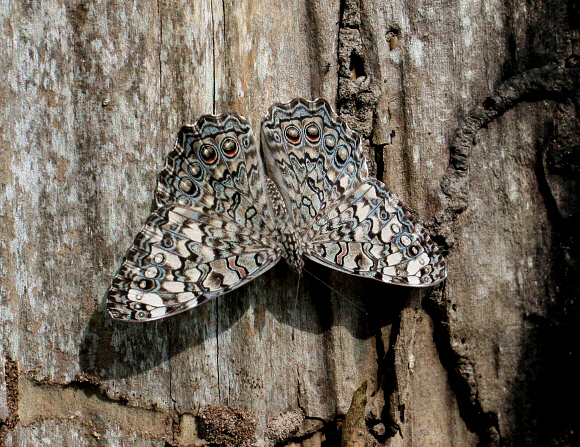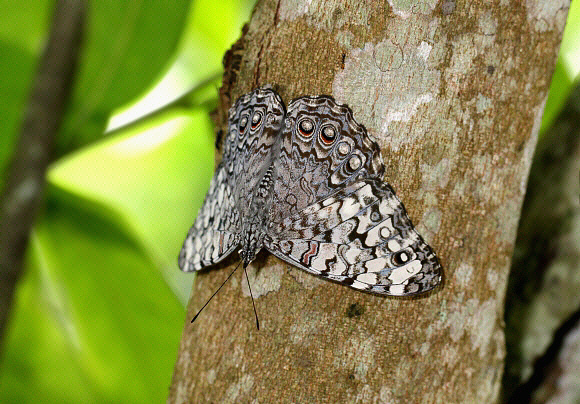
Hamadryas februa male, Yarinacocha, Ucayali, Peru- Adrian Hoskins
Introduction
There are 20 members of the genus Hamadryas. Most are found only in Central and South America, although 8 have been recorded sporadically in the southern USA.
The butterflies are commonly known as Crackers due to the ability of the males of several species to produce a sound similar to the crackling of bacon in a frying pan. The sound is produced as the butterflies take off, and is made by twanging a pair of spiny rods at the tip of the abdomen against bristles on the anal claspers. Only males can produce the sound, but both sexes can detect it – their wings have tiny hollow cells covered in membranes that vibrate in response to sound, and stimulate nerve endings. The purpose of the sound is not known. It may possibly deter competing males from occupying the same territory, or could act as a trigger to initiate the first response from a female during courtship.
All Hamadryas species have a beautiful calico pattern on the upperside. In many there is a series of submarginal ocelli on the hindwings, and distinct kidney-shaped stigmata in the discal cells of fore and hind wings. In several species such as februa and glauconome the ground colour is greyish and the pattern acts as an extremely effective camouflage against the bark of trees. In others such as amphinome, laodamia and velutina the wings are velvety black with a blue sheen and a pattern of bright blue spots.
Photographing Hamadryas can be a frustrating experience, as both sexes spend most of their time basking high up on tree trunks, often 10 metres or more above the ground. They sit there for hours with wings outspread, always facing downwards to keep a watchful eye for potential mates. At times they descend and bask much lower down, at a height of just a couple of metres, but at the slightest disturbance they immediately fly back to the tree top. They remain there until the intruder has left the vicinity, and then descend the tree trunk in a series of short hopping flights, dropping a short distance each time until after half an hour or so they have resumed their original position.
Hamadryas februa is easily confused with feronia, but unlike the latter it has red crescents within the ocelli on the hindwings. Hamadryas februa is the commonest and most widespread member of the genus, being found from southern Texas to Uruguay and Paraguay.
 Hamadryas februa, male, Yarinacocha, Ucayali, Peru – Adrian Hoskins
Hamadryas februa, male, Yarinacocha, Ucayali, Peru – Adrian Hoskins
Habitats
This species is found in degraded rainforest and deciduous forest habitats, including orchards and the forested margins of cattle ranches, at altitudes between sea level and about 1200 metres. Hamadryas februa, male, Yarinacocha, Ucayali, Peru – Adrian Hoskins
Hamadryas februa, male, Yarinacocha, Ucayali, Peru – Adrian Hoskins
Lifecycle
The eggs are white and laid singly on Dalechampia ( Euphorbiaceae ).
Adult behaviour
Hamadryas februa is often seen basking on tree trunks, adopting a head-downward posture, with the wings flattened against the bark. Males bask in this position for long periods to await potential mates. They commonly settle at a height of about 2m but if disturbed immediately take flight. After a few seconds they resettle, usually higher up on the same tree trunk. They remain there until the threat passes, and then descend the tree trunk in a series of short flights, dropping lower each time until after several minutes they resume their original position.
The butterflies are active from sunrise to sunset, and are rarely seen away from tree trunks, but also sometimes bask on rock faces or tree foliage. On a few occasions I have also seen them settling on the ground in lightly vegetated forest clearings.
